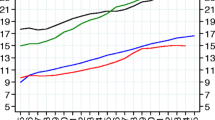Abstract
This article presents an estimation of the elasticity of actual wages to industry-level collective bargaining thereby quantifying empirically the role of industry-level bargaining on wage determination. For this purpose, we use a unique employer–employee panel dataset covering the entire Belgian employment population over 9 years (1998–2006). Like several other European countries, e.g. Germany, France, Italy and the Netherlands, Belgium has a relatively centralised wage bargaining system, with the industry level playing the most important role. Regression results confirm that wage increases collectively decided at the industry level are, on average, fully passed on to individual wages. In addition to industry-level bargaining, we are interested in the supplementary wage increases granted at the firm level, referred to as wage drift or wage cushion in the literature. Our estimates show that wage drift is affected by company size, by the economic performance of the industry and to a much lesser extent by labour market tensions as measured by the local unemployment rate. Interestingly, our results show that industry-level bargaining also takes most of these features into account.
Similar content being viewed by others
References
Albæk K, Asplund R, Blomskog S, Barth E, Guðmundsson BR, Karlsson V, Madsen ES (1999) A wage curve in the Nordic countries? Paper presented at the SOLE conference, Boston
Arellano M, Bond S (1991) Some tests of specification for panel data: Monte Carlo evidence and an application to employment equations. Rev Econ Stud 58: 277–297
Arellano M, Bover O (1995) Another look at the instrumental variables estimation of error-component models. J Econom 68: 29–51
Baltagi BH, Blien U, Wolf K (2009) New evidence on the dynamic wage curve for West Germany: 1980-2004. Labour Econ 16(1): 47–51
Bassilière D, Bossier F, Lebrun I, Masure L, Stockman P (2007) Le programme national de réforme de la Belgique. Effets macroéconomiques des charges sur le travail. Working Paper no 1107, Federal Planning Bureau
Blanchflower DG, Oswald AJ (1994) The wage curve. MIT, Cambridge
Card D (1995) The wage curve: a review. J Econ Lit 33: 785–799
Card D, de la Rica S (2005) Firm-level contracting and the structure of wages in Spain. Ind Labor Relat Rev 59(4): 573–592
Cardoso AR, Portugal P (2005) Contractual wages and the wage cushion under different bargaining settings. J Labor Econ 23(4): 681–723
Direction Générale Statistiques et Information Économique (2006) Enquête sur la structure et la répartition des salaires (SES)
Druant M, Du Caju Ph, Delhez Ph (2008) Résultats de l’enquête réalisée par la Banque sur la formation des salaires dans les entreprises en Belgique. Revue Économique (septembre), National Bank of Belgium
Estevão M, Tevlin S (2000) Do firms share their success with workers? The Response of Wages to Product Market Conditions. Economica 70: 597–617
Fakhfakh F, FitzRoy F (2004) Basic wages and firm characteristics: rent sharing in French manufacturing. Labour 18(4): 615–631
Fakhfakh F, FitzRoy F (2006) Dynamic monopsony: evidence from a French establishment panel. Economics 73: 533–545
Goos M, Konings J (2001) Does rent-sharing exist in Belgium? An empirical analysis using firm level data. Reflets et Perspectives XL(1–2):65–79
Green F, Machin S, Manning A (1996) The Employer size-wage effect: Can dynamic monopsony provide an explanation?. Oxf Econ Pap 48: 433–455
GroupeS (2010) Aperçu mensuel des adaptations salariales. http://www.groupes.be
Hartog J, Leuven E, Teulings C (2002) Wages and the bargaining regime in a corporatist setting: the Nederlands. Eur J Polit Econ 18: 317–331
Holden S (1998) Wage drift and the relevance of centralised wage setting. Scand J Econ 100(4): 711–731
Izquierdo M, Moral E, Urtasun A (2003) Collective bargaining in Spain: an individual data analysis. Servicio de Estudios del Banco de España. Documento Ocasional No. 0302
Janssens S, Konings J (1998) One more wage curve: the case of Belgium. Econ Lett 60: 223–227
Jung S, Schnabel C (2009) Paying more than necessary? The wage cushion in Germany. IZA Discussion Paper No. 4278
Lallemand T, Plasman R, Ryckx F (2005) Why do large firms pay higher wages? Evidence from matched worker-firm data. Int J Manpower 26(7/8): 705–723
Manning A (2003) Monopsony in motion: imperfect competition in labour markets. Princeton University Press, Princeton
Montuenga-Gómez VM, Ramos-Parreño JM (2005) Reconciling the wage curve and the Phillips curve. J Econ Surv 19(5): 735–765
Montuenga-Gómez VM, García I, Fernandez M (2003) Wage flexibility: evidence from five EU countries based on the wage curve. Econ Lett 78: 169–174
Moulton BR (1990) An illustration of a pitfall in estimating the effects of aggregate variables on micro units. Rev Econ Stat 72(2): 334–338
Nijkamp P, Poot J (2005) The last word on the wage curve?. J Econ Surv 19(3): 421–430
Ordine P (1996) Wage drift and minimum contractual wage: theoretical interrelationship and empirical evidence for Italy. Labour Econ 2: 335–357
Plasman R, Sissoko S (2005) Gender wage gap in an international perspective. Cahiers Economiques de Bruxelles 48(4): 419–442
Plasman R, Rusinek M, Ryckx F (2007) Wages and the bargaining regime under multi-level bargaining: Belgium, Denmark and Spain. Eur J Ind Relat 13(2): 161–180
Roodman D (2006) How to do xtabond2: an introduction to difference and system GMM in Stata. Working Paper No. 13, Center for Global Development
Author information
Authors and Affiliations
Corresponding author
Rights and permissions
About this article
Cite this article
López Novella, M., Sissoko, S. Understanding wage determination in a multi-level bargaining system: a panel data analysis. Empir Econ 44, 879–897 (2013). https://doi.org/10.1007/s00181-012-0554-8
Received:
Accepted:
Published:
Issue Date:
DOI: https://doi.org/10.1007/s00181-012-0554-8




